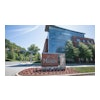Fisk University officials believe in getting young people turned on early to the idea that math is cool. So each summer they host science summer camps for middle school students where they introduce them to the rudiments of technology and engineering and try to interest them in studying the subjects in college.
Fisk also reaches out to high schools. It has a traveling science exhibit that teaches teens about astronomy, specifically about the sky and the stars. Through all these outreach efforts, Fisk officials try to drive home one important point:
“We teach them that, no matter what science you’re talking about, math is really fundamental,” says Dr. Arnold Burger, professor of physics and vice provost of academic initiatives at Fisk University.
The K-12 outreach builds on another legacy that has earned Fisk considerable national attention in recent years: the Fisk-Vanderbilt Bridge program. Under this program, students complete their master’s degrees in one of the sciences such as physics, chemistry, biology, astrophysics or material science and then go on to Vanderbilt or one of several other universities for their doctorates.
The program currently has about 60 students enrolled, most of whom are from underrepresented groups.
The master’s degree program is rigorous but also is designed with a wide safety net to help those students who enter with deficiencies.
“If students arrive with deficiencies, we put in place interventions,” Burger says. “At the undergraduate level we do the same thing. At the graduate level we have a peer mentoring project. To ensure success we need to establish a community. It takes a village to develop the next generation of leaders.”
Not Making the Grade
Many experts give our nation’s schools a poor grade for their approach to teaching mathematics and for their preparation of mathematics teachers. While many policymakers make much of data that suggest children in the United States lag behind many other advanced countries in math, many experts call for a change in mathematics education, particularly at the elementary and K-12 level. Still others say the nation’s colleges of education must re-think the way they prepare math teachers. Such steps, they say, are necessary components to overall efforts to successfully steer more students toward careers in STEM fields.
Dr. Alfred Posamentier, dean of the college of education at Mercy College in New York, says the kind of training that teachers of mathematics get in college and in graduate school has a direct impact on students’ interest in mathematics at the K-12 level. Most teachers, he says, teach to the test and don’t know how to inspire students to develop a love for mathematics.
“They learn how to teach, plan a lesson, but not how to motivate them to like mathematics,” says Posamentier, the author of several books on mathematics and mathematics instruction. In some instances, he says, math teachers usually know no more than what is in the text of the one math subject they are teaching that term.
“That’s analogous to someone teaching ‘Hamlet’ having not read any other Shakespeare plays,” he says. “To teach a subject you have to know more than just that subject.”
Since coming to Mercy College two years ago, Posamentier says he’s made some significant changes in the graduate mathematics education program. He says he’s replaced about half the faculty and has radically updated the course offerings in order to give students a broader perspective about the subject of mathematics. For instance, students now take classes such as the history of mathematics. If teachers are going to inspire students to love mathematics or to take an interest in a STEM career, he says, then math teacher education must be changed.
Posamentier blames standardized examinations for hurting mathematics instruction, particularly in states like New York.
“Years ago you taught a course and maybe in the last week of the term the teacher would say for practice let’s look at [test] questions,” he says. “Today — and I’ve seen this — in mid-September [math teachers are] teaching what’s going to be on the test. They’re not doing anything that’s not going to be on the test. That has been killing creativity; it’s killing teaching and it’s just terrible. Since No Child Left Behind, the push has been on how to move the achievement of youngsters up, and, in doing that, they have made testing paramount over everything else.”
That’s an assessment shared by Dr. John Woodward, dean of the School of Education at the University of Puget Sound in Tacoma, Washington.
“If you look at the international situation they are far less obsessed with this testing than the United States is,” he says. “In Canada (the focus) is around professional development. Here it narrows the curriculum extensively.”
Linda Gojak, president of the National Council of Teachers of Mathematics, an organization of more than 80,000 math educators, says that in many cases math education falls short because teachers fail to help students understand the reasoning behind the subject.
“Too often math instruction has been about teaching how to do procedures and not why they work,” she says. “If they don’t understand why they work then they won’t understand when they work. Everything you do in math should make sense. There’s a reason behind why everything we do in math works. I think we have to keep this in front of our minds. Are we helping kids to make sense of what’s going on? Mathematics that is taught procedurally does not work. We know more about how kids learn mathematics now. We really have to work harder at giving kids opportunities to make sense of what they’re doing.”
A Global Perspective
Dr. Peter Kloosterman, a professor of math education at Indiana University, says some perspective is needed in understanding the performance of students relative to their peers abroad.
“People think the U.S. used to be so much better in math and science,” says Kloosterman. “There is no evidence to back it up. Certainly things are improving. When you look at the national data, elementary and middle school students are doing a lot better in math than they did 20 years ago. We’re not making very much progress at [the] high school level.”
Experts say a couple of other factors hinder mathematics education: the lack of diversity among the nation’s K-12 teachers and the absence of a rallying cause that further inspires young people to consider math or subjects that have a basis in math as an option. “One of the things that’s happening is we’re pushing test scores higher for students who want to be teachers,” says Kloosterman.
“One of the issues with underrepresented students is they can’t pass the state test in Indiana. That’s cutting out a lot of students.” Woodward says that 85 percent of the nation’s elementary teachers are White females.
“There’s a big disconnect between the population and schools,” says Woodward, who describes math as a major gatekeeper that prevents many students from graduating high school. “There’s a huge problem we face in recruiting candidates of color. That leads to a bigger issue of cultural competence that’s added to our plate. Issues of identity and staying in school need to be communicated in a variety of ways.”
Burger says America’s pre-eminence in graduate education masks a deeper problem.
“The U.S. is still tops when it comes to grad schools but not high school or undergrad. If you don’t have [a] full pipeline of talent coming all the way from middle or high school then you’re missing out on talent,” he says.
What the nation needs today, he says, is the same kind of cause that motivated Americans after the Soviets launched Sputnik, the world’s first artificial satellite, more than half a century ago. “Today we need to make sure there are new challenges that will inspire and attract the young people,” he says. D


















